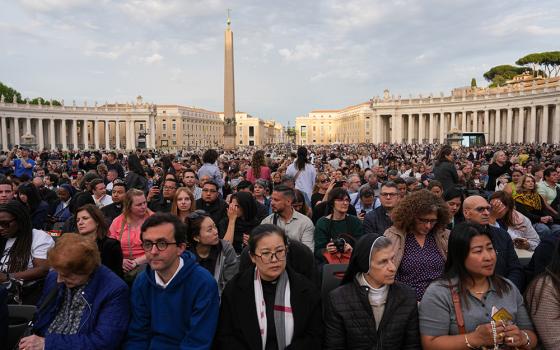Traditionally, the Chrism Mass is said on the morning of Holy Thursday, the same day as the commemoration of the Last Supper, given its strong emphasis on the presbyterate. In Rome, the Chrism Mass is said at St. Peter’s in the morning and then the Pope goes to his cathedral (St. Peter’s is not a cathedral; it is a very large church), St. John Lateran, across town in the evening for the Mass of the Lord’s Supper. Here in Washington, we often use the National Shrine for large events such as priestly ordinations, but the Chrism Mass and the Mass of the Lord’s Supper, these are reserved for the Cathedral.
Regular NCR readers may recall an article I wrote for our print edition about the significance of cathedrals in the worship of the local diocese. In light of so many controversies, defending the role of bishops these days is enough to garner a bunch of nasty comments, to be sure. Bad enough to have a high Christology, but a high ecclesiology! That is too much! But, if it is true, as Blessed John Henry Newman said, of the laity, “the Church would look foolish without them,” the Chrism Mass would look foolish without the bishop. To whom would the priests renew their ordination vows? Who would preside? I know that there are times when a see is vacant, and I suppose a retired bishop or an apostolic administrator undertakes these tasks. In Washington, of course, our Chrism Mass has three cardinals in attendance – the incumbent, cardinal Wuerl, his predecessor Cardinal McCarrick, and his predecessor once removed, Cardinal Baum – so there is no shortage of people who could preside in a pinch, but it would seem odd, abnormal, not quite right, to have anyone except the ordinary leading this service.
Have you ever had the experience of visiting Washington’s National Cathedral? It is a very impressive gothic revival building. (I say “revival” not because it departs from strict medieval forms in favor of Victorian flourishes: It does not. But, unlike, say the Church of San Jose in San Juan, Puerto Rico, which is gothic because that was how they built churches back in 1521 when it was begun, the National Cathedral was begun in the late nineteenth century.) The stained glass windows are magnificent. The stone carvings are breathtaking. The wood choirstalls make one want to be a chorister again. But, when I go there, I never feel like I am in a church, more like I am in a sort of religious museum. I mentioned this to a priest friend, and he said, “Of course it doesn’t feel like a church. There’s no Blessed Sacrament!” My hand hit my forehead: “Duh!” Of course that was why I felt that way. We Catholics enter a new church building, and what do our eyes look for first? A tabernacle. I would suggest that mutatis mutandi, a Chrism Mass without the bishop would be like a church without the Blessed Sacrament. It may be splendid, but it does not feel right, or at least it does not feel Catholic.
In many cathedrals in recent years, they have installed ambrys in prominent locations to hold the sacred oils that are blessed at the Chrism Mass. Indeed, some churches now display the oils as well. This is all to the good. Our sacramental system is not only one of the most distinctively Catholic things about us, it expresses a truth it is sometimes easy to forget: Grace is everywhere. And, it reminds all who look at the oils in the ambry that those oils were blessed by the bishop at the Chrism Mass. Those oils are drawn from the same urns as the oils at the cathedral. They remind the local church of its existential link to the bishop: Every time those oils are used to anoint the sick or baptize a child, the relationship with the bishop is reaffirmed.
The relationship of the laity with the bishop is not something small. Even when we in the laity criticize our bishops, be that criticism from the right or the left, we are in effect asking that the bishop live up to the high standards of his office. The Catholic Church does much good and it has made many mistakes. Sometimes, it appears that the bishops present the Church’s teachings in crimped, narrow ways, other times, in ways that humanize and enlarge the human spirit. But, if our Church fails to recognize its apostolic roots, and the apostolic succession that keeps those roots vibrant into our own time, our Church has ceased to be Catholic. The Chrism Mass helps remind us all of this vital link without which we might be noble, we might be scoundrels, but we are not meaningfully Catholic.


